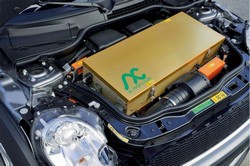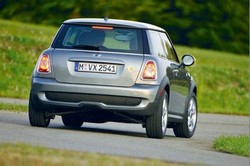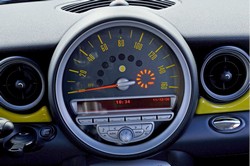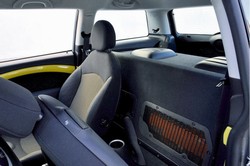MINI Cooper E
The MINI Cooper is already a cracking drivers' car but now it has been fitted with an electric motor. Adam Towler finds out if eco can still be fun...
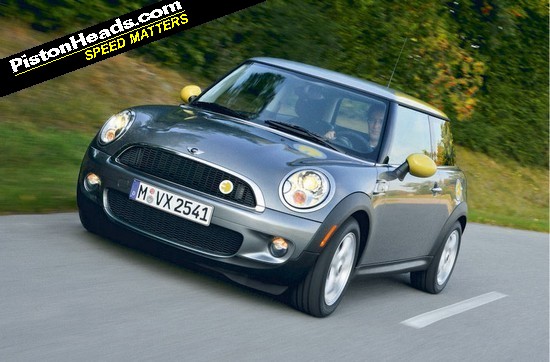
The MINI E has obvious green bits – mirrors, decals and trim in the colour – but the nice thing is that it looks like, well, a MINI. It doesn’t look weird, or exaggeratedly cute, or like it’s made from organic materials. Or like a Prius. It just looks like a MINI.
The ‘E’ is an all-electric vehicle, not a hybrid or an alternative fuel car. It looks the same as ever because it started life on the production line at BMW’s Oxford plant before being shipped to Munich for fitting out with its special innards. This is not a production car, but a ‘field experiment’ in BMW speak, where 500 ‘E’s will be leased to American consumers in California, New Jersey and New York.
You have to apply online to be in with a chance of being selected - and around 10,000 have already done so. Since their initial announcement, BMW has confirmed that 50 MINI Es will be leased in Berlin, with another 50 coming to the UK.
It uses an electric motor and lithium-ion batteries from California-based AC Propulsion (the company also behind powering the Tesla roadster) but it is co-developed with BMW’s engineers, although BMW say future cars are likely to be developed in-house, and the outsourcing here was to speed up the car’s introduction.
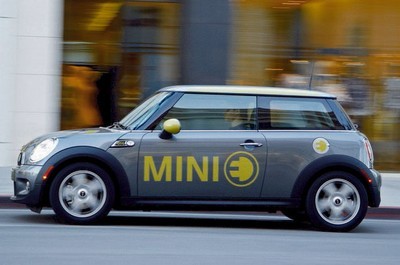
The rechargeable battery is made up of 5,088 cells grouped into 48 modules that are packaged in three main elements. This battery pack has a maximum capacity of 35kWh (Kilowatt hours) and transmits energy to the motor at a direct current of 380 volts. What does that mean in old money? Try 201bhp, and 162lb ft of torque developed from… zero rpm.
Range and recharge time depend on your driving style and electricity respectively, but they reckon on up to 150 miles for the former, with the latter taking under three hours in the UK with BMW’s wall box. Sadly, those batteries weigh 260kg (bringing this Mini’s kerbweight up to a portly 1465kg) and their size obliterates not only the rear seats, but most of the boot too.
Of course, whether electric cars are the solution, part of the solution or none of the solution; what the actual environmental problem is, whether there’s a problem and who’s fault that is, are all discussions to set alight any forum. But in the limited space available here I’m just going to attempt to describe how it drives, based on a quick fang around the block on a freezing Monday afternoon in Munich.
Hand on heart, I honestly can’t remember the last time I was so excited to be handed the keys to a car, a buzz borne out of the realisation that this car might just be the future. Well, I say ‘keys’, in reality it’s a disc fob and starter button combo: pressing that button does nothing more noticeable than wake a few lights on the dashboard and send the power dial needle (where the rev counter would normally be) racing around to the current reading.
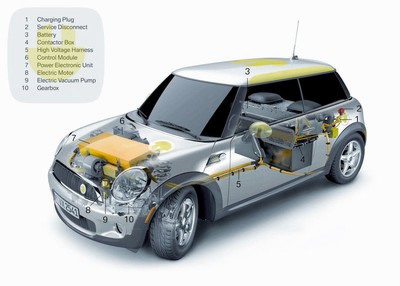
So you pull the auto shifter down into ‘D’ like you would any automatic and, gingerly – because it’s surprising how a stride into the unknown tempers your inputs when it comes down to it – depress the accelerator pedal. Nothing happens. I push down a little further, and without further delay I feel the car begin to move; silently, almost imperceptibly, wheels start to rotate.
I push harder still, and out we go, through the raised shutter door and onto the street, the MINI E whirring softly under ‘power’. After a few seconds your foot/brain partnership has sussed the appropriate sensitivity required to match expected forward motion with pedal pressure. So I do what most us would do – unable to resist the temptation for any length of time, I floor it.
There’s a momentary scrabble at the front wheels, a nagging tug on the wrists and then the neurotic blinking of the traction control light, so I back off, and try again, this time squeezing the throttle progressively. From the corner of my eye I can see my passenger’s head jolt into the headrest, but this visual confirmation isn’t required: the accelerative force is fantastic, a never-ending surge that has me grinning with genuine surprise.
A 95mph top speed might not sound too promising, but the way this MINI jabs forward from 30 to 60mph is hilarious - the ‘E’ feels quite a bit faster on the move than the 8.5sec 0-62mph figure suggests. But what about the lack of noise, you say? I’ll admit, all I could think of was milk floats before driving the ‘E’, but again, I’m pleasantly surprised.
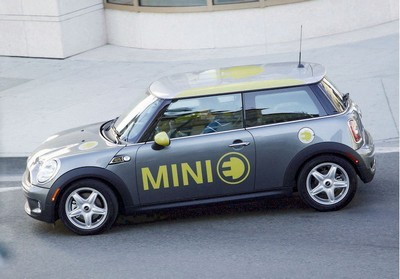
The rising whine/whistle/whoosh makes me think of a pair of J-79 jets in the back of an old Phantom fighter winding up (ok, that requires a real stretch of the imagination, but what can I say - the MINI E had put me in a positive mood!). I like it. It sounds, well, futuristic I suppose: quite urgent in its own way.
And the more you accelerate, the more purposeful it sounds, plus you get increasing road and wind noise to judge your speed by. Once you’ve got to 60mph, the effect of the last two – without an ‘engine’ blotting them out – really illustrates the energy required to push an object through the air at higher speeds.
Perhaps the weirdest thing about driving the ‘E’ is the significant ‘engine braking’ when you lift off the accelerator as kinetic energy is returned to the battery. Once you’re used to it, you can drive in traffic without virtually ever touching the brakes, because the effect is like driving into a vat of treacle in a Disney cartoon. It does mean however that you have to develop a very sensitive right foot as you’re effectively driving the car from just one pedal.
Otherwise, the ‘E’ feels remarkably like any other MINI, at least on this brief drive around town. The steering is perhaps a touch heavier than memory recalls, but despite the weight increase the car still feels lively and keen to change direction, with all the directness that defines the MINI personality.
Excluding the numerous external challenges for a minute, it’s the size, weight and range of the battery pack that really limits the MINI E: we lost around 30% of charge in under 20 miles of driving, although admittedly that was ‘revving’ its electrodes off. Nevertheless, I cannot deny that having driven the MINI E, I suddenly feel a good deal more optimistic about the future.
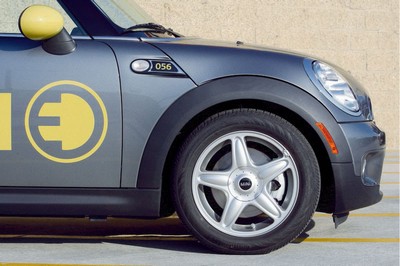
| Mini E | |
| Engine | Asynchronous electric motor |
| Maximum power | 201bhp |
| Maximum torque | 162lb ft of torque |
| Kerb weight | 1465kg |
| 0-62mph | 8.5sec |
| Maximum speed | 95mph |
| Capacity | 35kWh – 28kWh of which is useable |
| Charge time | @ 240V/48A 2.9 hours |
| Peak current | Short bursts of up to 900A |
I'd consider one for my 50 miles a day commute, depending on costs (purchase and running), but I do believe cars like this have a future. It may only suit a certain market, but its a very big one.
Gassing Station | General Gassing | Top of Page | What's New | My Stuff

